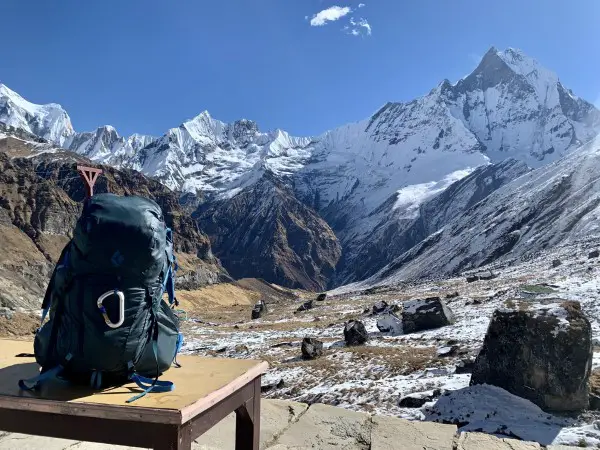
Completing your gear and packing are among the most crucial aspects of preparing for your trek in Nepal, especially if it’s your first high-mountain trip. It can be quite challenging, as you need to ensure that everything fits into your backpack. At the same time, you must be prepared for the unpredictable weather conditions in the world’s highest mountains.
Before embarking on my first trek in Nepal, I spent hours searching on the internet, trying to understand what I should bring with me. As I gained practical experience with each subsequent Himalayan trek, the contents of my backpack slightly changed, moving away from theoretical knowledge towards what actually worked. Creating the optimal packing list for a trek in Nepal has been a journey in itself.
In this blog post, I’ll share some practical tips as well as the essential packing list for treks in the Himalayas. This guide is applicable to treks in both the Everest and Annapurna regions.
What's in this blog post?
I. PACKING TIPS FOR A TREK IN NEPAL

1. The less the better
If you’re carrying a backpack on your own back, stick to the essentials—because you’ll quickly regret it if you don’t. The initial days of the trek are typically the most challenging. Your back isn’t used to the weight of your backpack, and the lower-altitude sections of the trek are relatively warm. All the bulky cold-weather gear like a down jacket, fleece, beanie, and gloves are tucked deep inside your backpack, making it feel heavy. Initially, all your snacks are still in your backpack, or at least they should be😉 But here’s the good news: it gets easier every day. Your back hurts less, and the backpack feels lighter.
When packing, keep two things in mind: pack everything necessary to keep you safe and warm in the mountains, but avoid overpacking. Before packing a specific item, always ask yourself: what will happen if you don’t have it? If the answer is nothing serious, leave it behind.
You really don’t need much to be happy in the mountains. I always come to the same conclusion: the less I have, the happier I am. But what exactly constitutes the absolute minimum for a trek in Nepal? I’ll share that with you shortly.
2. Backpack weight vs. body weight
It’s believed that the weight of your backpack shouldn’t exceed 20% of your body weight. From my experience, I can confirm that this is a reasonable guideline. For instance, I weigh 60kg, and the maximum weight of my backpack was 12kg. I truly believe my body couldn’t handle more. When packing, keep in mind that a full 1-liter water bottle and a full 0.5-liter thermos of tea add another 1.5 kg to your load that you need to consider.
3. Invest in good quality equipment
This investment is not only for your comfort but also for your safety. I understand that it can be easier said than done, but if you have the financial means, it’s truly worth it. The last thing you want at high altitudes is wet feet, a broken trekking pole, or a shoe held together with duct tape. Carrying a massive and heavy sleeping bag that doesn’t provide adequate warmth at night isn’t the wisest choice either.
Quality gear tends to last longer, making the initial cost savings somewhat illusory. High-quality equipment is usually lighter, warmer, more practical, comfortable, and, most importantly, safer. If you can’t afford to invest in all high-quality gear, consider prioritizing decent hiking boots, as they are the most important element of a successful trek.
4. Dress in layers
Wearing multiple layers of breathable clothing is key to staying comfortable in ever-changing weather conditions. If it gets too warm, you can easily remove a layer, and when it cools down, you can put it back on.
5. You only need two sets of clothes
When packing for a trek in Nepal, keep in mind that you only need two sets of clothes: one for daytime trekking and another for the guesthouse and sleeping.
6. Don’t worry if your budget is limited
There’s a solution. You’ll find shops with affordable trekking equipment on almost every corner in Kathmandu. Some stores even offer the option to rent a down jacket or a sleeping bag, which can be a cost-effective alternative if you’re on a tight budget or prefer not to purchase expensive gear.
II. PACKING LIST FOR A TREK IN NEPAL
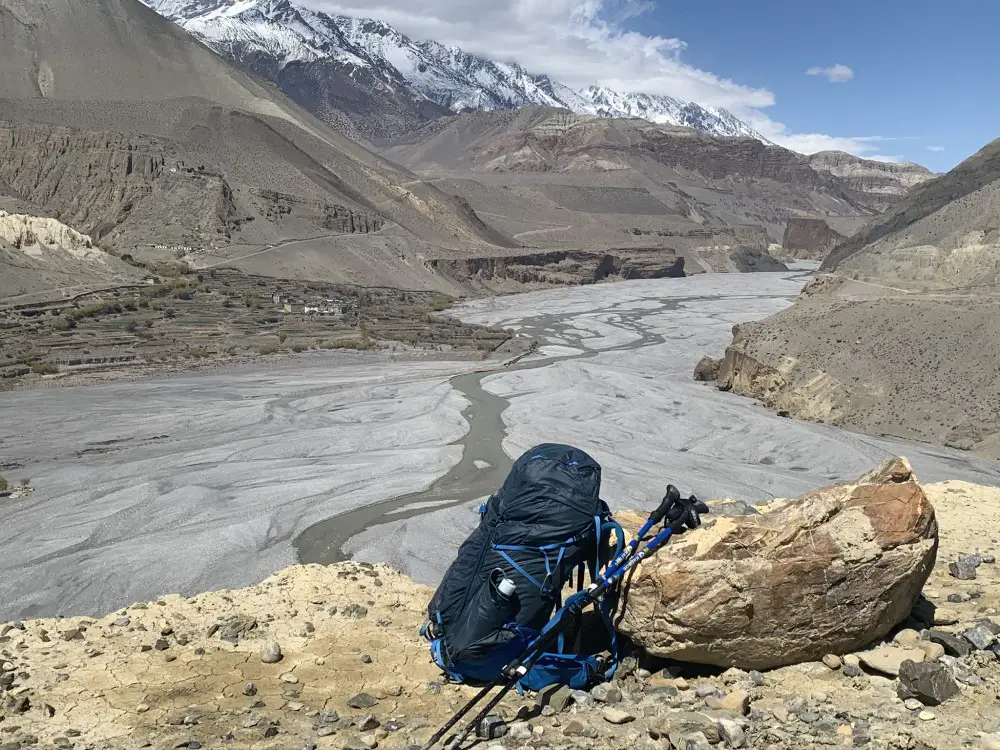
My mountain gear has been a combination of high-quality items (hiking boots, down jacket, merino wool thermals etc.) and cheaper stuff (trekking poles, poncho, t-shirt etc.) which works fine with me. Here is the full list with details and links.
1. Personal Items
PASSPORT WITH A VALID NEPAL VISA
With the exception of only a few countries, most foreign nationals can obtain a tourist visa upon arrival at the airport. The cost of the tourist visa depends on the duration of your stay in Nepal:
- 15 days: $30 USD
- 30 days: $50 USD
- 90 days: $125 USD
It is best to pay for your visa in USD at the airport, as card payments are generally not accepted. Make sure to bring cash with you.
Nepal Immigration Official Website
MONEY
Payments in Nepal are typically made in the local currency, Nepalese rupees (NPR), which cannot be obtained abroad. If you plan to carry cash, it’s best to bring US dollars, which are widely accepted.
You can also withdraw Nepalese rupees from ATMs in Kathmandu. However, it’s important to note that in the mountains, especially during treks, access to ATMs and credit card facilities is limited.
The absolute daily minimum budget for a trek in the Himalayas is approximately 20 USD (around 2500 NPR). While you may end up spending less, you should always carry more cash with you. ATMs and credit cards are not reliable options in remote mountain areas. Having enough cash to cover your entire trek and additional expenses is essential for a smooth journey.
TRAVEL INSURANCE
The type of insurance you need depends on the altitude you plan to reach during your trek. In most cases, your insurance should cover trekking activities up to 5500 meters above sea level. This level of coverage is typically not included in basic policies, which often cover hiking only up to 3500 meters. Therefore, it’s important to check whether your policy includes additional options for high-risk activities like high-altitude trekking.
MOBILE PHONE WITH APPS
Staying connected with the outside world and your loved ones is important during your trek, but your smartphone will serve you in more ways than just communication. While great photos capture amazing memories, carrying a camera will add significant weight to your backpack, which can be challenging when trekking uphill in thin air. Consider using your smartphone for photography instead.
Additionally, your smartphone can be a great navigation tool. My favorite app – Maps.Me offers free offline navigation, helping you find your way even in remote areas. I also love the PeakFinder app that can identify mountain peaks.
PHONE CHARGER
Nepal operates on a 230V – 50Hz voltage system, and most European power plugs work in Nepal. However, be aware that some plugs may fit slightly loosely due to a minor size difference.
POWERBANK
Having a power bank is essential during your trek, especially since your phone serves as both a camera and a map. It’s crucial to ensure your power bank is always charged because power cuts are a common occurrence in Nepal, not only in the mountains but also in the cities. Charging your phone and power bank is usually possible in lodges for a small fee.
2. Backpack
BACKPACK 50-65L
A 50-65L backpack should be suitable for the trek. For me, the key factor was the weight of the backpack. I opted for the Black Diamond Element 60L pack because it’s a lightweight minimalist backpack, weighing only 1.5 kg. Most backpacks with a similar capacity tend to weigh over 2 kg. I must admit, it was love at first sight, partly because of its beautiful colour, although aesthetics should never be the sole determinant in such a decision. Well, we all have our weaknesses… 😉
Fortunately, my choice turned out to be excellent. An essential feature of any backpack is a good hip belt, as the majority of the weight should rest on the hips rather than the shoulders.
Your backpack is your home

#Insider tip
How you wear the backpack can be just as important as the type of backpack you have. Properly adjusting all the straps is crucial. If you’re not sure how to do it, check out this short video: HERE
BACKPACK RAIN COVER
If your backpack doesn’t come with a built-in rain cover, you need to get one. A rain cover will protect your backpack, electronics, and dry clothes from getting soaked during heavy rain. When selecting a rain cover, it’s usually better to opt for a larger one rather than a smaller one to ensure it can completely cover your entire backpack. I know what I am talking about as I speak from experience. You can often find these covers at affordable prices in Kathmandu, available in many trekking shops in Thamel, or buy them cheaply on Amazon. That’s where I got mine.
3. Sleeping bag
Do you need a sleeping bag?
The blankets provided in the guesthouse rooms may not offer adequate protection against the chilly Himalayan nights at high altitudes. Additionally, you may never know when these blankets were last cleaned, possibly quite a while ago.
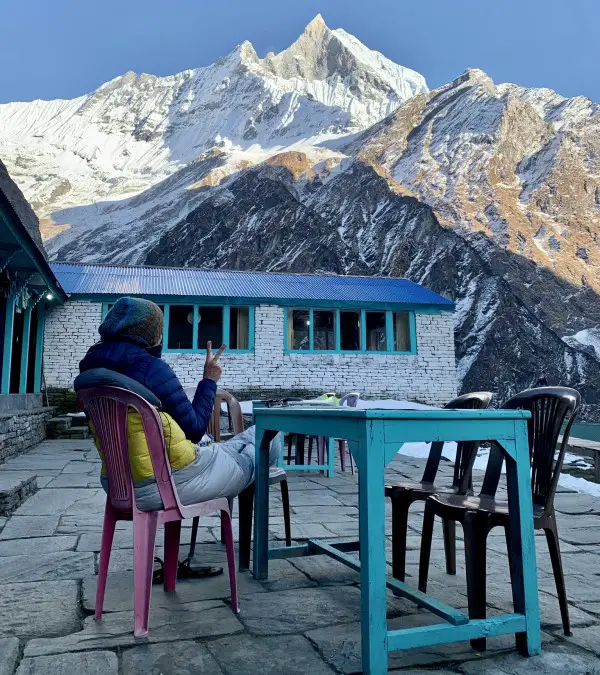
While some trekkers opt to go without, I believe that having your own warm sleeping bag is essential for a comfortable & safe trek.
What factors should you consider while selecting a sleeping bag for a trek in Nepal?
When selecting a sleeping bag for high-altitude trekking in Nepal, you should consider two main factors: comfort temperature and type of filling.
Comfort Temperature: This is the lowest temperature at which you will not feel cold. If you plan to spend a night above 4000 meters, you should buy a sleeping bag with a 0°C rating. At night, temperatures can drop significantly. At about 5000 meters on the Everest Base Camp trek, my water froze in the bottle next to my bed.
Type of Filling: In cold and dry conditions, feather down filling works better than synthetic material. It offers an excellent weight-to-heat ratio, making down sleeping bags the warmest, smallest, and lightest. Although they are more expensive than synthetic alternatives, they tend to last longer. When choosing a down sleeping bag, pay attention to the fill power; higher values are better. For Himalayan conditions, I recommend a sleeping bag with a fill power exceeding 700 cubic inches (cuin). Be cautious of cheap imitation sleeping bags sold in Nepal, as they may not provide the same level of warmth and protection against the cold.
What sleeping bag did I choose?
Without breaking the bank, my goal was to find the smallest and warmest sleeping bag possible. My two biggest concerns were being cold and struggling with a heavy backpack. After some research, I decided on an 800 cuin feather down sleeping bag by Forclaz, which I found at the affordable outdoor store, Decathlon. While it did cost me around 150 USD, looking back, it was a fantastic investment. Branded sleeping bags like eg. North Face etc. cost much more.
I never felt cold during my treks. In Gorak Shep, at an altitude of 5164 meters, where many trekkers shivered from the cold, I was actually too warm and had to unzip the bag. I even had to remove some layers. On the coldest night, I used a hot water bottle to generate extra heat inside the sleeping bag, along with my merino wool thermals.
One of the great advantages of this sleeping bag is that when folded, it’s very compact and weighs less than 900 grams. If you’re interested in a newer version of this sleeping bag, you can find HERE.
The smaller and warmer it is, the better!
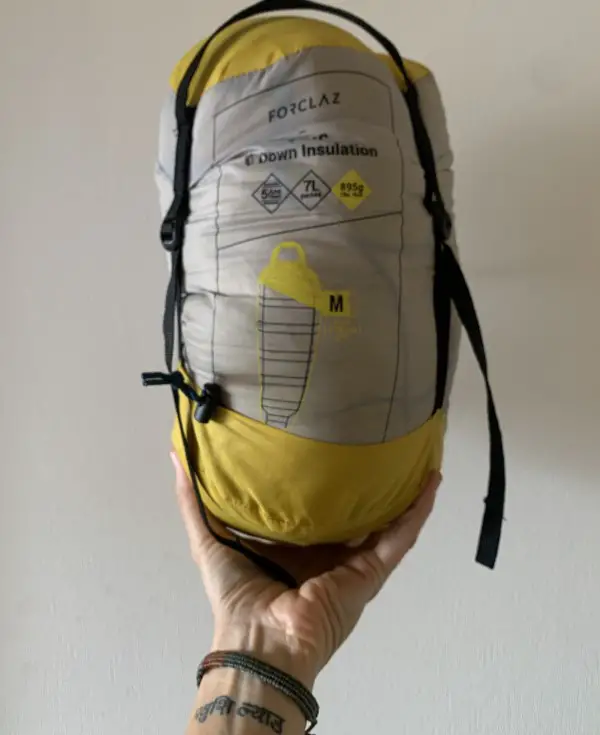
#Insider tip
The sleeping bag doesn’t generate heat; rather, it retains the heat produced by our bodies, which then warms the air inside the sleeping bag. Therefore, it’s best to enter the sleeping bag when you’re already warmed up. If you’re feeling cold, try doing some squats or jumping jacks before getting in. You should wear a maximum of one layer of clothing, preferably thermal underwear. Adding extra layers acts as a barrier to heat transfer and can make it more difficult for your body to warm up the interior of the sleeping bag. It’s a common mistake to wear everything you have, including a jacket and fleece, while inside a sleeping bag, which can ironically make you feel colder.
4. Footwear
HIKING SHOES
Good shoes are the single most crucial element of your gear when trekking in Nepal. Poorly chosen shoes can transform what should be a beautiful trek in the Himalayas into a nightmare. Some people believe that the most popular trails in the Himalayas can be hiked in ordinary sneakers. While it’s theoretically possible, especially in good weather, luck may not always be on your side. But what if it snows or rains heavily for an entire day and you have no time to rest in your busy itinerary and must walk for several hours?
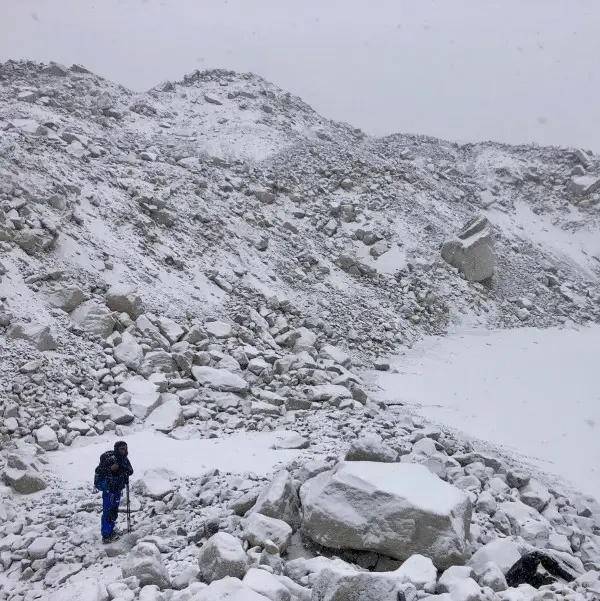
Crossing Kongma La Pass - although the sky was blue when I left in the morning, I ended up hiking for long hours in bad weather.
I personally witnessed the suffering of people wearing sneakers who contemplated turning back during their trek. Mountain weather is very unpredictable, and heavy rain or snowfall can occur unexpectedly on any given day of hiking, regardless of the season or altitude. Have I convinced you to get some proper hiking shoes?
Therefore, you should get shoes equipped with a membrane, with Gore-Tex® being the most renowned option, ensuring water resistance. These shoes should not only protect your feet from uneven terrain but also provide excellent grip on slippery surfaces. Opting for high trekking boots offers ankle support and stability in all conditions, whether it’s mud, rain, or snow. This becomes especially crucial during multi-day treks when carrying a heavy backpack.
I know that some of you will disagree but for Himalayan journeys, I highly recommend purchasing all-season hiking boots. While they may feel a bit warmer in the lower sections of the trek at higher temperatures due to reduced breathability, it’s a small compromise to make up for the enhanced water resistance they provide.
What hiking shoes did I get?
I chose La Sportiva mountaineering boots, specifically the Trango Trek Micro EVO GTX model. This renowned Italian brand has long years of high mountain tradition. During the Annapurna Circuit trek I experienced hours of walking through the snowy Thorong La Pass at an altitude exceeding 5,000 meters. I probably was the only person whose feet remained dry.
I highly recommend investing in all-season boots, particularly if you plan to trek in spring when the snow likelihood is higher than in the autumn. You can find more information about my La Sportiva hiking boots model HERE
My La Sportiva boots


turned great in the bloody fight against leeches and...
...when it snowed - I didn't have to dry them like other people did

#Insider tip
When trying on hiking boots, wear thick socks. The insole should extend about 1 cm beyond your foot. It’s best to try on shoes in the afternoon when feet tend to swell slightly. Trekking shoes should be slightly bigger than your regular shoes. This extra space is crucial during steep and lengthy descents to protect your toenails from painful bruising.
SLIPPERS / SANDALS
As for slippers or sandals, you’ll need them when taking a shower and moving around teahouses. Opt for a lightweight and comfortable pair. For my first trek, I chose flip-flops, which weren’t the best choice when wearing thick woolen socks. Since then, I’ve switched to sports sandals, and they have turned out to be great. Teva sandals are one of the most popular options. I currently use Japanese Montbell sandals, but I have used Teva sandals before
MICRO SPIKES
They might be useful when crossing snow-covered and icy passes. It’s better to buy them cheaply on Amazon or in Kathmandu. You wouldn’t want to regret not having them on an icy trail.
5. Clothes
DOWN JACKET
What makes a good down jacket for a trek in Nepal?
Despite its compact size and light weight, a down jacket provides remarkably effective cold protection and takes up very little space in your backpack, thanks to its compressibility. It’s simply the best for trekking in Nepal. Similar to a down sleeping bag, a high-quality lightweight jacket can be relatively expensive. When choosing a jacket, focus on the quality of the down filling. The warmest jackets feature a down and feather mixture, typically with 90% down (goose down is considered the best) and 10% feathers. Pay attention to the fill power as well, with the best technical jackets reaching a fill power of 900 cuin.
The high price of top-quality jackets reflects the ethical treatment of animals in the production process, which includes a commitment to never plucking feathers from live birds. Rigorous monitoring of the down supply chain and stringent regulations ensuring humane living conditions for birds contribute to the higher cost of down jackets.
What down jacket did I get?
I chose the Down Sweater Hoody (800 cuin) by Patagonia, known not only for its exceptional quality but also for its highest ethical standards. While I paid quite a lot (~ 250 USD), I have no regrets because I have never felt cold in this jacket. I particularly like its high collar and insulated hood. The jacket’s built-in pull cords, located in the pockets and on the hood, enable a snug fit, providing better protection against cold and piercing winds. It’s exceptionally lightweight and windproof, making it a long-term investment for me. I hope to enjoy its warmth and comfort for many years.
If you have the opportunity to buy a high-quality jacket, it is undoubtedly worth investing in your own comfort. You can find more information about my Patagonia down jacket HERE.
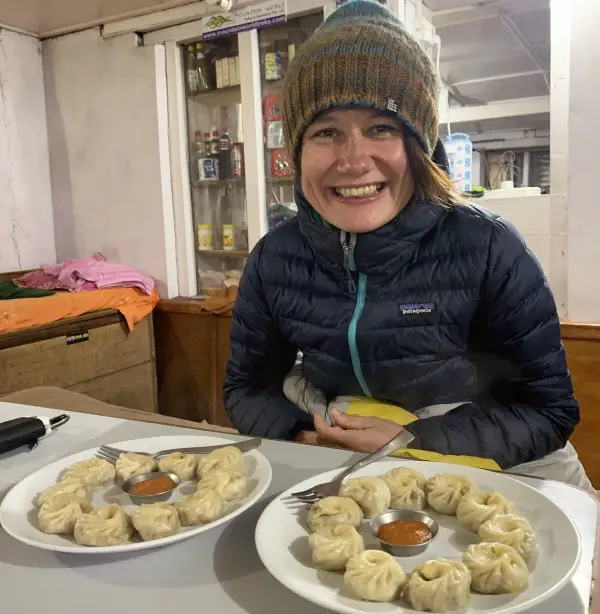
ME & my down jacket + momos = Happiness
PONCHO/RAIN JACKET
While some trekkers opt for branded rain jackets, if you already have a good down jacket to protect you from cold and wind, a poncho can be enough for the rain protection.
During most of my Himalayan treks, I relied solely on an inexpensive poncho. It’s only recently that I bought a rain jacket for improved breathability for hiking in warmer mountains in Japan, which I also used on my recent Annapurna Base Camp (ABC) trek. I still like my poncho because it is longer compared to a jacket, providing good rain protection. Additionally, it occupies very little precious space in my backpack and it was very cheap. In Kathmandu and Pokhara, you can find good quality ponchos for a very reasonable price.
GAITERS
I didn’t have gaiters on my first Himalayan trek. Despite having fantastic waterproof shoes, my feet still got wet. When it rains or snows heavily, water or snow can enter your shoes from the top. Gaiters provide protection not only for your feet but also for the lower part of your legs, keeping them dry. I bought mine in Zakopane, Poland, and they have served me well. You can easily find them everywhere, also in Kathmandu. Additionally, gaiters have proven to be excellent protection against leeches during one of my treks at the end of the monsoon season in Nepal.
#Insider tip
Before buying, try the gaiters on with your hiking boots to ensure a proper fit. The size and type of the gaiters is very important, as not all gaiters are compatible with every type of boot. You should be able to put them on easily because when you need to use them, it’s typically during heavy rain or when you’re dealing with leeches.
FLEECE
This is an essential outer layer for colder days during any trek and is great for evenings in the teahouse. Avoid cotton sweatshirts as they dry slowly, which can be a serious problem during intense physical activity. My Patagonia fleece, made from recycled polyester, dries quickly and keeps me warm. You can check out this model HERE
#Insider tip
Opt for a hoodless fleece when wearing it under a jacket. If your head gets cold, simply wear a beanie.
WATERPROOF PANTS
These should provide protection against heavy rain, wet snow, cold wind, and low temperatures. I found affordable waterproof pants in Kathmandu, and they have served me well. I only wear them over leggings in the lowest temperatures at the highest altitudes, typically in the early morning.
T-SHIRT (1-2)
Choose t-shirts made of synthetic fabric or merino wool to minimize sweat absorption, ensure quick drying, and keep them lightweight. I brought only one t-shirt, which I purchased at Decathlon for 7 USD, and I loved it. These t-shirts occupy little space, so you can consider taking more than one. Check out the model of my t-shirt HERE
LONG-SLEEVED T-SHIRT
Opt for one made of synthetic breathable fabric. I chose one with a zip so I could easily layer it over a t-shirt. I primarily used it at the beginning of the trek when it was still too warm for merino wool thermal layers. I bought mine AIRism Full-Zip Hoodie at Uniqlo. You can find it HERE
In lower parts of the trek I usually wear only a long sleeve

THERMAL UNDERWEAR (Base Layers)
I mainly hike wearing a long-sleeved shirt and leggings, which can be replaced with trekking pants, an equally great choice. In Nepal, there is a great selection of cheap trekking pants, so you can buy them here.
To keep warm in the high mountains, merino wool made from merino sheep in New Zealand is the ideal material for base layers. It perfectly keeps moisture away, allows your body to breathe, and offers excellent thermal insulation. This means it retains heat against the skin when it’s cold and provides protection against heat when it’s hot. It’s like magic!
Additionally, due to its antibacterial properties, merino wool is odor-resistant. My merino wool base layers never develop an unpleasant smell even after several days of intensive hiking. The only drawback is the higher price, but the investment is well worth it. I purchased mine from Icebreaker, and even after numerous treks, the underwear looks as good as new.
#Insider tip
While brand matters to some extent, what’s more crucial is the merino wool content in the base layers. The higher the percentage of merino wool, the better. My base layers worked exceptionally well because they are made of 100% merino wool. So, before making a purchase, check the tag carefully. Below links to my Icebreaker Merino Women’s 260 base layers.
PAJAMAS/GUESTHOUSE WEAR
As mentioned earlier, wearing a single layer of clothing is sufficient to stay warm in a sleeping bag. A merino wool long-sleeved shirt and leggings (also suitable for men, with the option to wear shorts over the leggings) are the ideal choice. They are comfortable, warm, and odor-resistant. I purchased mine, which contains 80% merino wool, from a more affordable brand than Icebreaker. While there is a noticeable quality difference, it is good enough for sleeping.
TREKKING SOCKS (2 pairs)
Avoid cotton for socks. Choose socks made of synthetic or wool material as they wick moisture away and regulate the temperature inside your shoes. Feet tend to sweat during treks, so sock material really matters.
#Insider tip
It’s better for socks to be slightly too small than too big, as loose socks can lead to blisters. Believe me, I know something about it.
WARM SOCKS (2 pairs)
These should be woolen, with merino wool being the best option. They come in handy on colder trekking days and in the evenings at the teahouse.
PANTIES (2 pairs) & SPORTS BRA (1)
I took the absolute minimum and washed my panties daily. You can opt to take more, but remember that each additional pair adds weight to your backpack.
BEANIE
This is a must-have, useful not only during the trek but also while relaxing in the sleeping bag in the afternoon before the dining room’s heating is turned on. You’ll essentially wear it all the time.
BUFF
Buffs are very versatile and can be used as a scarf, hat, headband, and even a mask to protect against dust and dry air. Although I purchased mine in Pokhara for 5 USD, you can buy it also on Amazon. I particularly like this design.
SUN PROTECTION HAT
Initially, I used a buff scarf, but recently I switched to a baseball cap. If you have a favourite hat or cap, be sure to bring it.
GLOVES
Comfortable, close-fitting thin fleece gloves are suitable for most of the trek. However, mornings at high altitudes can be very cold, so it may not be enough. I always carry a second pair of thick winter ski gloves, which are great for trekking above 4500m.
6. Gadgets
TREKKING POLES
Initially, I was skeptical about buying trekking poles because I associated them with elderly people. However, I’m now a huge fan of them! They protect your knees when descending steep hills and improve your balance in mountainous terrain. They also make life easier when ascending in thin air with a heavy backpack.
In Nepal, you can find trekking poles everywhere. I bought my first poles for 15 USD in Thamel. Although they were fake Marmot poles, they worked great for many years during several treks in Nepal and Japan. Only recently I got a new pair of Black Diamond poles on Amazon, as one of the Marmot poles was bent and did not close anymore. Although my Black Diamond poles are great and very pretty 😉 if you are hiking beginner you can opt for a cheaper option.
SUNGLASSES
These are a very important element of your mountain gear because the sun’s intensity is much stronger at high altitudes. To reduce the snow blindness risk, wear high-quality lenses that ensure protection against UV radiation (category 3 or 4)
Read more about the risk of snow blindness while trekking the Himalayas: RISKS WHEN TREKKING IN NEPAL WITHOUT A GUIDE
HEADLAMP FLASHLIGHT
A must-have item. It comes in handy not only during sunrise hikes but also in situations where there is no electricity or when you need to go to the toilet at night. Make sure to carry spare batteries. I bought Black Diamond Equipment Cosmo 350 Headlamp and I’m very happy about it.
MAP
While the free Maps.Me offline navigation app is useful, it is so nice to have a traditional map. While planning the next day’s trek with a cup of delicious masala tea and a map on the table, I am the happiest.
#Insider tip
Avoid buying maps in your home country. Nepal offers a vast selection of the most updated maps. In the Annapurna region, new routes are continually being developed to reduce walking time along the jeep road, so having the latest map can be beneficial.
Read more about the risk of getting lost while trekking in Nepal: RISKS WHEN TREKKING IN NEPAL WITHOUT A GUIDE
E-BOOK READER
Evenings in the mountains can be long, especially on shorter trekking days when you only walk for 4-5 hours. Books downloaded on my Kindle helped me to make the most of my time in the sleeping bag.
Chilling time
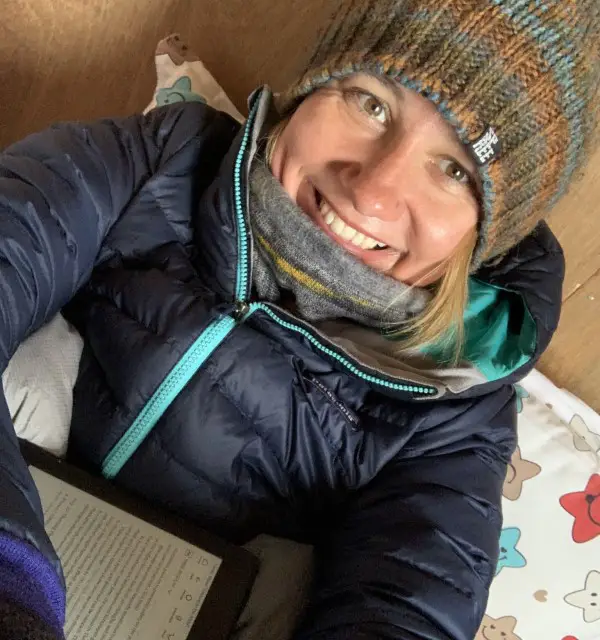
DUCT CAPE
It takes up minimal space and can be incredibly useful. You can use it to repair almost anything. It can be a real lifesaver at high altitudes when something breaks. Duct tape saved me once when I could fix my broken flip-flops. Everything you carry is essential, or at least it should be, and there are no stores to replace items. It’s a must-have item.
THREAD & NEEDLE
These tiny items can be invaluable for making emergency repairs to gear or clothing while on the trek.
7. Toiletries
TOWEL
Preferably made of microfiber, as it dries quickly, is lightweight and takes up minimal space.
TOILET PAPER
You won’t find it in the toilets along the trek, so always carry it with you. While you can buy it in every village, it’s likely to be the most expensive toilet paper you’ve ever purchased. But what can you do if you need it?
WET WIPES
These are essential, especially if there’s no shower available. In the Everest region, I relied on “wet wipe showers” for at least 5 days.
HAND SANITIZER GEL
This is a great option when you can’t wash your hands, which is likely to happen during the trek.
HIGH SPF SUNSCREEN
The sun is much stronger at high altitudes and can cause severe sunburn. You should use sunscreen with a high SPF rating, ideally at least 30 or even 50.
LIP BALM WITH SPF FACTOR
Harsh conditions like chilly winds, strong sun, dry air, and low temperatures can lead to chapped and sore lips. This applies to both men and women
SOAP & SHAMPOO BAR
This is an optimal solution as it takes up very little space.
OTHER
Consider packing moisturizing cream, roll-on deodorant, toothpaste, and a toothbrush in small travel-sized containers.
8. First Aid Kit
PAINKILLERS
Choose the type that suits you best.
COLD & FLU MEDICATION
Opt for medications in sachets, which can be dissolved in hot water, providing relief and warmth in the cold mountains.
THROAT LOZENGES
Dry and cold mountain air often leads to a troublesome cough, commonly referred to as the “Khumbu cough.”
ANTI-DIARRHEA MEDICATION
Given the less-than-ideal sanitary conditions at high altitudes, it’s wise to include medication for stomach problems.
ALTITUDE SICKNESS REMEDY
Acetazolamide, sold in Nepal under the name Zolamide, is available over the counter at most pharmacies in Kathmandu. A pack of 10 tablets typically costs around 100-200 NPR (1-2 USD).
ADHESIVE BANDAGE
9. Food & Drinks
WATER BOTTLE
Don’t buy bottled water in the mountains. It is expensive and what’s worse, the plastic pollution you generate will stay in the Himalayas forever. Unfortunately, recycling in Nepal is not very popular. Instead, use a reusable water bottle.
I chose the Nalgene plastic bottle, known for its high quality, which I’m very happy about. Despite many falls, it never broke or leaked. I love that Nalgene bottles are heat resistant. I could pour boiling water into the bottle and place it in the sleeping bag during the coldest nights.
WATER PURIFICATION SYSTEM
Consider using water treatment tablets, a water filter, or a SteriPen for water purification.
Most of the time, I trekked in Nepal using water treatment tablets, which are the most common and cost-effective option. Recently, I decided to buy the Katadyn water filter, and I am very happy with it. Both options worked great for me. It really depends on what’s best for you and how much you are willing to spend.
Read more about the best methods of water treatment and reusable bottles here:
DRINKING WATER IN NEPAL WHEN TREKKING. THE PROBLEM OF PLASTIC IN THE HIMALAYS.
THERMOS
At high altitudes, the human body dehydrates very quickly, so it’s essential to stay hydrated. Drink regularly, even when you are not thirsty.
When it’s cold outside a hot tea tastes much better than ice water. I always carry a 0.5l stainless steel water bottle from the Swiss company SIGG, which keeps drinks hot for hours. Thanks to its convenient cap, the bottle can be opened and closed with just one hand.
Putting stickers from my travels on my bottles is like collecting treasures 🙂

SNACKS
I always carry snacks in my backpack in case I need an energy boost during my trek. Chocolate, nuts and dried fruit are a great source of energy. You can also find popular snack bars and biscuits like Mars, Sneakers and Digestives in villages along the trail, but they may be more expensive and have limited variety. So it’s always a good idea to stock up on your favorite snacks before the trek in Kathmandu or Pokhara.
TEA BAGS
If you’re a tea lover, consider bringing your favorite tea bags. They take up little space, and boiling water at high altitudes is usually more affordable than buying tea.
10. Optional Items
DAYPACK
It might be convenient for acclimatization hikes. Even though in Nepal, to reduce the overall weight of my bag, I always trek without it, I have this little foldable backpack that I use for my other adventures.
To be honest, it's tiny after folding & superlight (111 g/3.9 oz.), so you can also bring it with you.
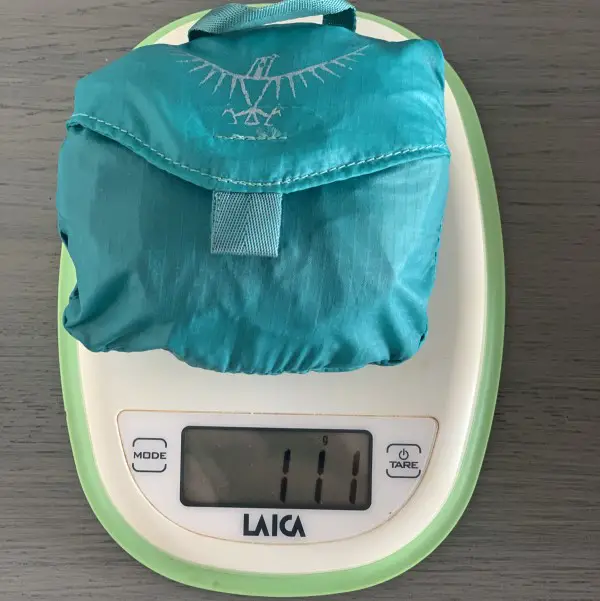
SOLAR POWER BANK
Especially in the Everest region, it is a good idea, because charging power banks at higher altitudes is quite expensive. While trekking around Annapurna, charging was free, but that can always change in the future.
MOSQUITO REPELLANT
Depending on the season and where you begin your trek, it’s worth carrying mosquito repellent with you. If you fly directly to Lukla, you won’t need it. However, if you are getting there on foot, or in the lower parts of the trek around Annapurna, it can be really useful. During the monsoon season, I recommend spraying it on your shoes – it deters leeches a bit.
THIRD PAIR OF SHOES
Some people take a lighter pair of shoes (such as sneakers) to change after a day’s walking. But I think that’s quite a lot of extra weight. I always hiked without and used only sandals as a change.
ANTIBIOTIC
A broad-spectrum antibiotic may always be useful.
VITAMIN TABLETS
Vitamin tablets are a good supplement in a high-altitude, vitamin-poor diet. By dissolving them in water, they will improve its taste, which may help people who do not like drinking plain water.
I hope you enjoyed reading this post, and more importantly, I hope you found it useful. I’ve done my best to share practical knowledge about what to pack for a trek in Nepal to make your preparations easier. Now, you have a clear idea of what’s in my backpack. If you have any more questions or need further assistance, feel free to ask. Happy trekking!
Some of the links in this post are affiliate links – if you purchase a product, I may earn a small commission at no extra cost to you. This helps offset the cost of running this blog. Thank you for your support!
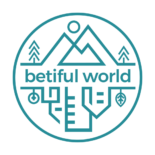
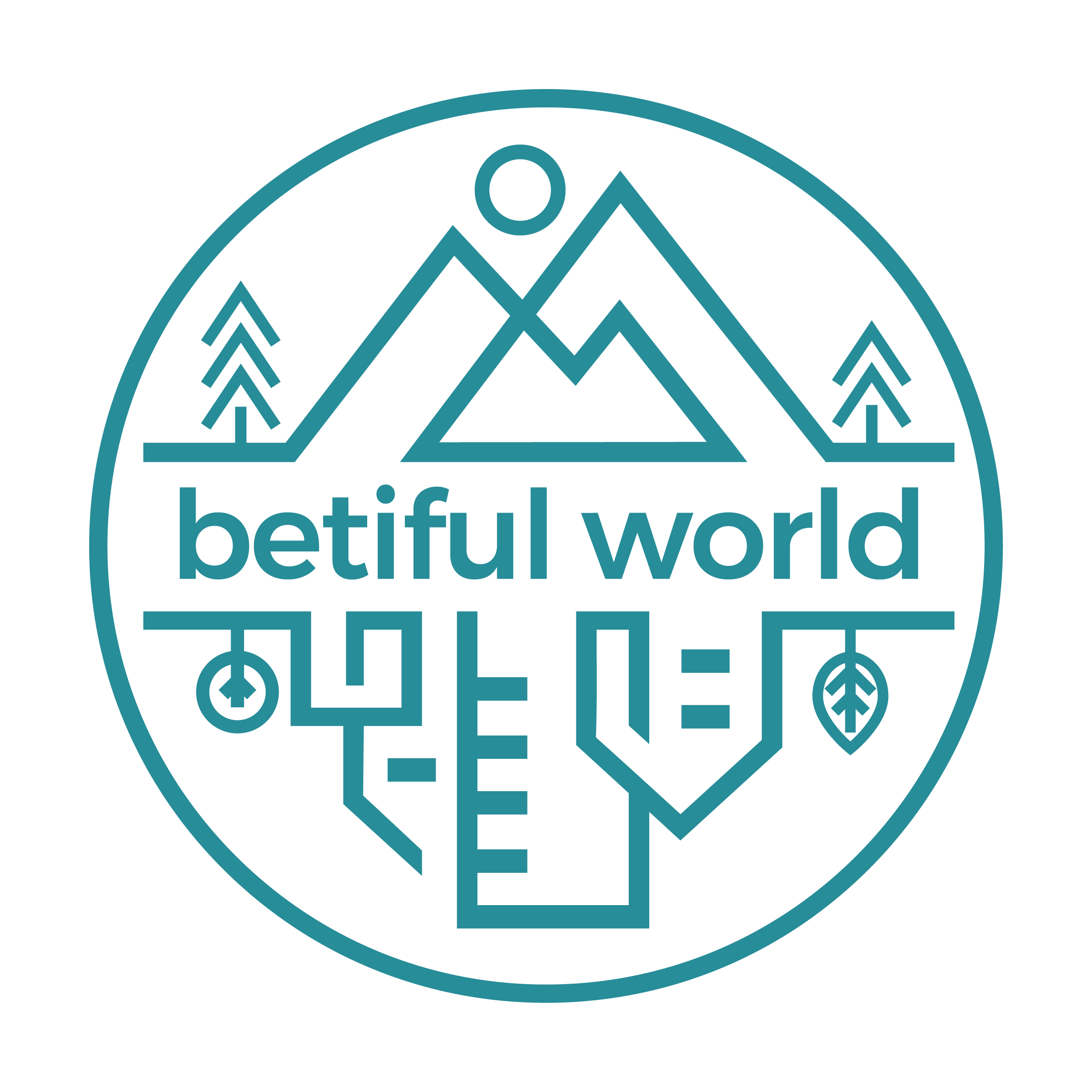
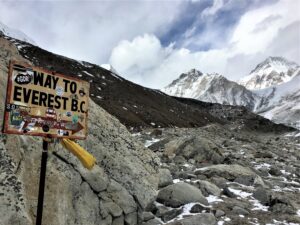
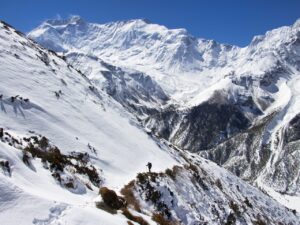

I am planning my Annapurna trek this November. Your packing information is very helpful. Thank you !
Hi Deborah! Thank you for looking into my blog and for your comment. It always make very happy 🙂 Pack light but take all you need to keep you warm & safe. And most importantly, enjoy this beautiful adventure <3
Hi Beti – I think this is the first blog I’ve read all the way through.
I’m doing an EBC Trek in March 2024 and although I have a kit list provided by the tour company – this is really useful.
The only thing I’m struggling to find are the four season boots.
I currently have Gortex Scarper but I’m not sure they’re equipped for snow conditions.
I’ve saved your blog link to my home screen so I can keep dipping back in for purchases.
Thanks again – Jules Xx
Hi Julie, THANK YOU for reading it all <3 It took me 3 years to write this blog post and multiple treks in Nepal, so I'm very very happy someone find it useful.
If your shoes are Gore Tex Scarpa, they are waterproof. And if they are almost totally rigid (it is hard to bend the sole) and have an ankle cuff helping to prevent snow from entering the boot they are likely to be 4-season boots. Have a wonderful trek & smooth preparations!
Hi Julie
I think that the excellent GoreTex boots made by Scarpa will be ideal for hiking to EBC. I have the Kailash model and they are awesome.
Good blog, sending it to my friend for his first trek in Nepal.
This is the best feedback I could get 🙂 THANK YOU, ROGER!
Superb content!
I completed a solo Annapurna in 2008 and at 64 I’m just about to try it again….thanks so much for taking the time to put this blog together, it’s the best out there. Wish me luck and good planning!
,
Hi Alexandra! You can’t imagine how much joy comments like yours bring me 🙂 Thank you! Remember that age is just a number! Take it slow (because it’s just too good to rush) and you’ll be fine! I’m very curious about your impressions. Trekking conditions must have changed a lot since 2008. The good thing is that the mountains are always just as stunningly beautiful 🙂 GOOD LUCK! You will rock it!